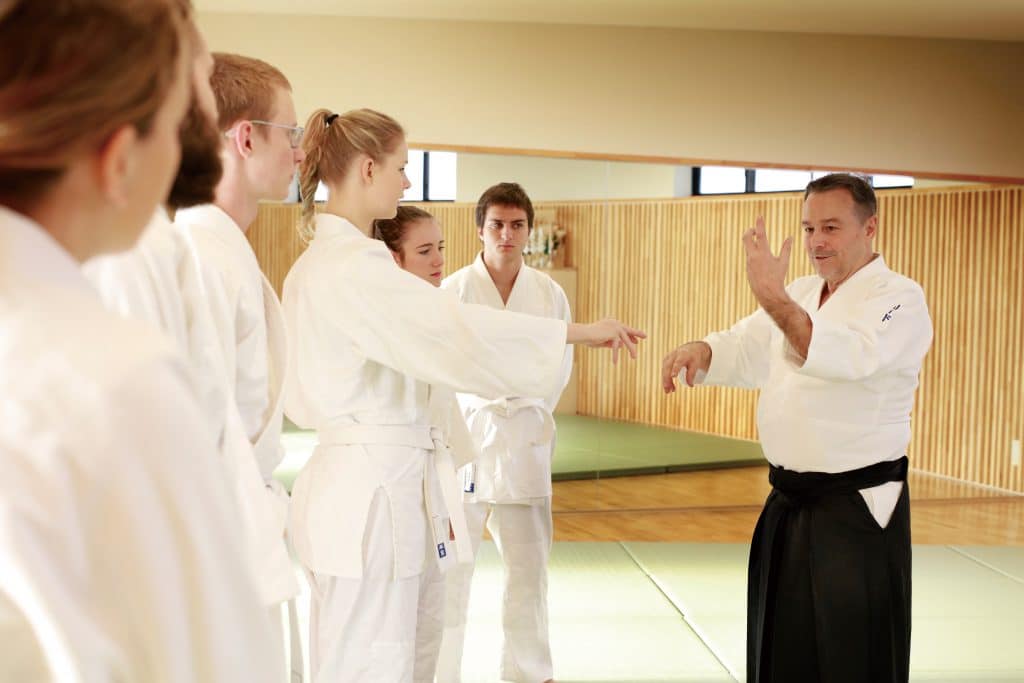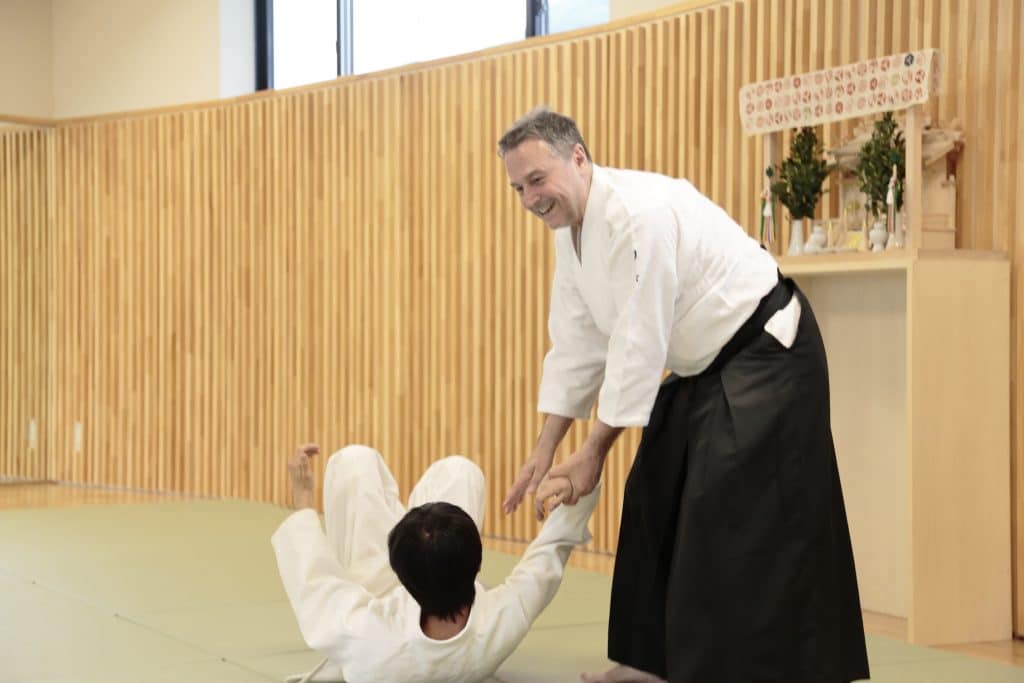The COVID-19 pandemic has changed the way universities approach teaching and learning, perhaps permanently. Switching to remote lectures was a challenge enough, but workshops that required hands-on instruction were a unique hurdle.
In this interview with Professor William Reed of the Japan Studies Program, we learn about how he has managed to teach his course in the Japanese martial art, Aikido, completely online this semester.
Some of Professor Reed’s key points on how he teaches Aikido online:
- Students are given detailed video close-ups of all of the Aikido Arts, including those by top Masters
- Students submit videos of themselves doing each of the exercises and arts, which are looked at together online
- Alternatives to the paired work were given for each exercise, so that students could practice without a partner
- These basic movements are known as Kata, and form the foundation for all paired work
- Students are given techniques for stretching, breathing, and meditation which helps them overcome stress and relax under pressure
Professor William Reed

Professor William Reed is a Professor of Japan Studies at iCLA. He teaches a wide range of courses: Aikido, Japanese Calligraphy, Samurai Culture, just to name a few. Having lived more than 40 years in Japan, Reed is a master of many Japanese arts. Reed holds an 8th Degree Black Belt in Aikido and a 10th Dan in Shodo (Japanese Calligraphy). He has also published books on Japanese culture and regularly appears on Yamanashi television and radio programs, as well as many nationally broadcast programs.
Aikido shaped the course of Reed’s life – it was why he had decided to come to Japan 48 years ago.
“I’ve been doing it for almost 50 years – I think this is the 48th year. I started in 1972, when you were still a little star in the sky,” Reed laughs. “I’ve been very fortunate to study with the top masters in the world, including several people who were the direct students of the founder.”
Online Resources: Learning From The Masters
Normally taught in the dojo in the iCLA building, Reed has had to move the course online onto Zoom due to the coronavirus pandemic.

“Aikido requires a dojo and a partner. It is very physical because you’re testing stability, spacing, movements, and learning how to fall. That is a huge challenge – how do you do that online?”
Although Reed has not been able to instruct his students in person, he has arranged for his students to learn from some of the best.
“I connected with a group in America called Aikido Journal and they have archives of masters, including my sensei’s, videos with complete instructions in English. I said to them – I’m teaching a college course and I’d really like to be able to, maybe for just 10 weeks, get access for my students,” As a well-known and respected figure of the Aikido world, Aikido Journal was more than happy to give Reed’s students lifetime access to the videos. ‘Oh! Thank you!’ I said.”
“So that was the first step. Because then, I thought, at least they can look at the masters.”
Interactive Aikido Online
“[Students] need to know nage’s part, which is the kata, and they also need to know uke’s part, which is the ukemi.” The nage is the thrower and the uke is the person who is thrown (the one who receives the technique). Of course, normally in Aikido, you would have a partner to train with.

“I know that it’s easy to make an excuse that we couldn’t go to the dojo, we couldn’t actually even touch each other. So how are we going to do this? But then I thought, how can I convert this to something even better than real training in the dojo.”
Reed started to pre-record videos demonstrating the techniques. “I made videos. I explain in the video in detail all of the movements, what they need to be careful of, the common mistakes… I give them everything that they need.” For their homework, students were to observe closely and practice. Adjustments were made to the paired work for each exercise, so students could train on their own without a partner.
During class, Reed separates the students into small groups on the online platform. “It would be two or three students in each breakout room, and I go around to each of the rooms and I spend about 15 minutes with each one,” Reed explains. “I ask them to show me what they’re working on – That’s pretty good, but let me see it from the side, do you see how your hand is too high, your hand should be at navel height – I walk them through it. Then they can see the before-and-after-coaching when they watch the recording.”
Not only are they watching videos of Reed and other Aikido masters, they are also watching videos of their own Aikido training. They could watch the recorded video footage of themselves, play it back, and revisit the personal feedback they received in class.
In a dojo, it would be difficult to set up cameras to film each student. Oftentimes, students forget feedback moments after stepping out of the dojo. Having video recording has changed the game, making it easier for students to review what they did in the class and improve.
Having a video also means that students can access the material if they happen to be absent for a class. Normally, it would be more difficult to catch up on missed content because the techniques taught in previous lessons would not be explained again on the same level of detail due to limited class time. With a video to review, there is a chance for them to catch up on what was taught in the previous class. Reed has also seen an improvement in student concentration and participation during training in this online teaching format.
Despite the many challenges to moving Aikido from dojo to online, students have been training well.
“They’re making a lot of progress!” Reed says proudly.

Reed’s Aikido workshop course emphasizes feedback and continuous self-improvement. There are no competitions, but through demonstrating what they have learned and receiving feedback, students build confidence over the course of the lessons and learn stability and calmness under pressure. Students also learn techniques for stretching, breathing, and meditating which help students to relax and overcome stress.
Hybrid of In-Person and Online Classes
Although distance learning has its great advantages, key elements of Aikido like paired partner practice, falls, and pins are impossible if students cannot train with another person.
However, this experience shows that online teaching can become a valuable asset to traditional classroom learning and instruction. Reed hopes that there could be a possibility for hybrid lessons that combine both online and face-to-face teaching when the pandemic situation is under control and it is safe to meet in person again.
“The big change for the better is the very specific individual feedback and a chance to review everything on video. That’s the big positive change,” Reed says.
“The change that’s not so good is if somebody is doing something wrong. For example, they have their arm out, there’s too much tension, and they don’t really know how to relax. I could explain to them, but it would be much faster if I could just go up and put one hand of their shoulder and one hand on their wrist and make it just right, or if they’re still tense I just shake it a little bit. So they get immediate physical bio feedback which is better than just verbal.”
“Ideally we’ll be able to do Zoom lessons like this, and also once every one or two weeks or so we’d meet in the dojo. Alternate and do a hybrid.”
The ongoing COVID-19 pandemic has forced higher education institutions to make immense changes to how teaching is delivered in order to ensure the safety of students, staff, and the community. However, these changes will perhaps pave the way for new, innovative methods of teaching that combine the benefits of teaching in the classroom and online instruction.

